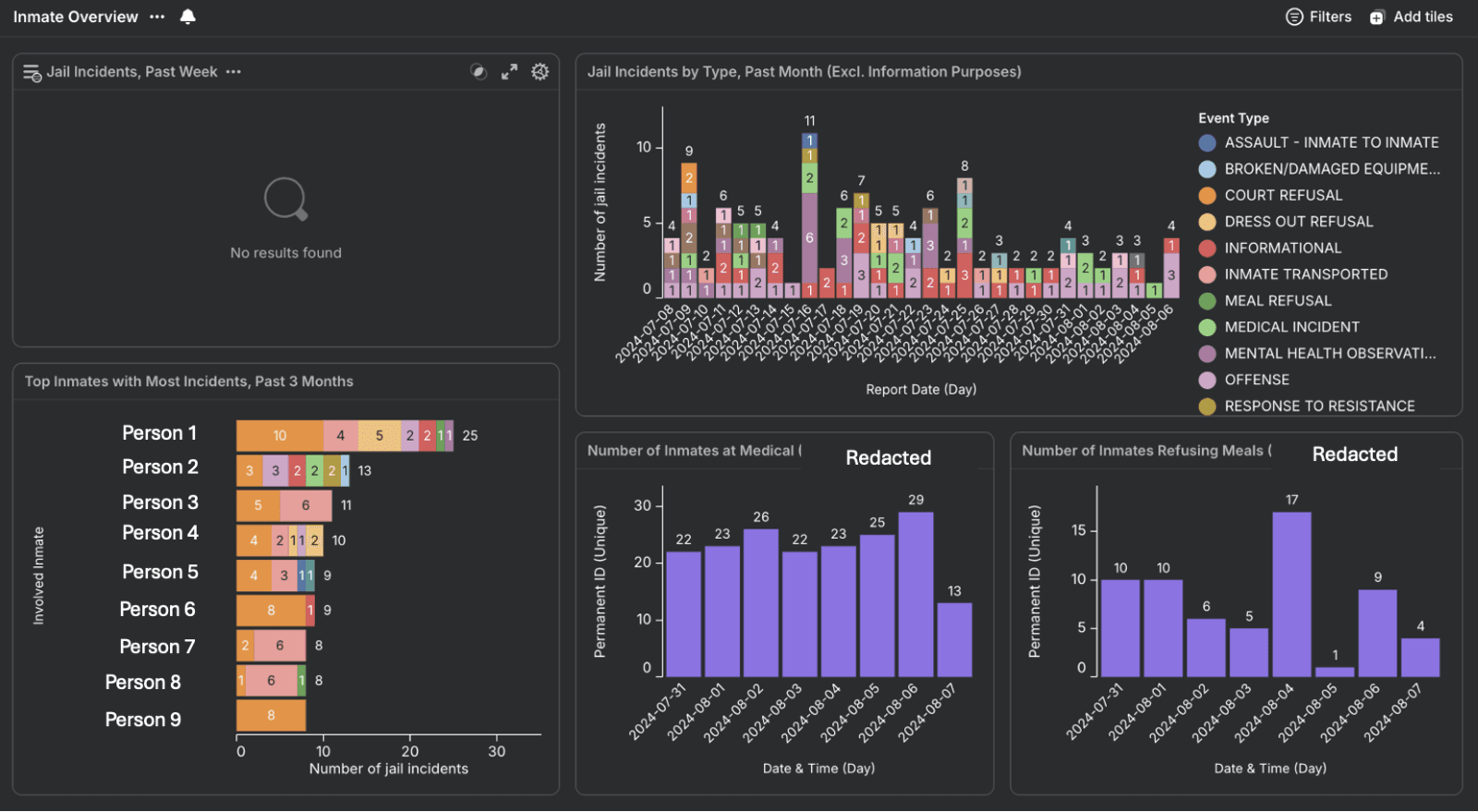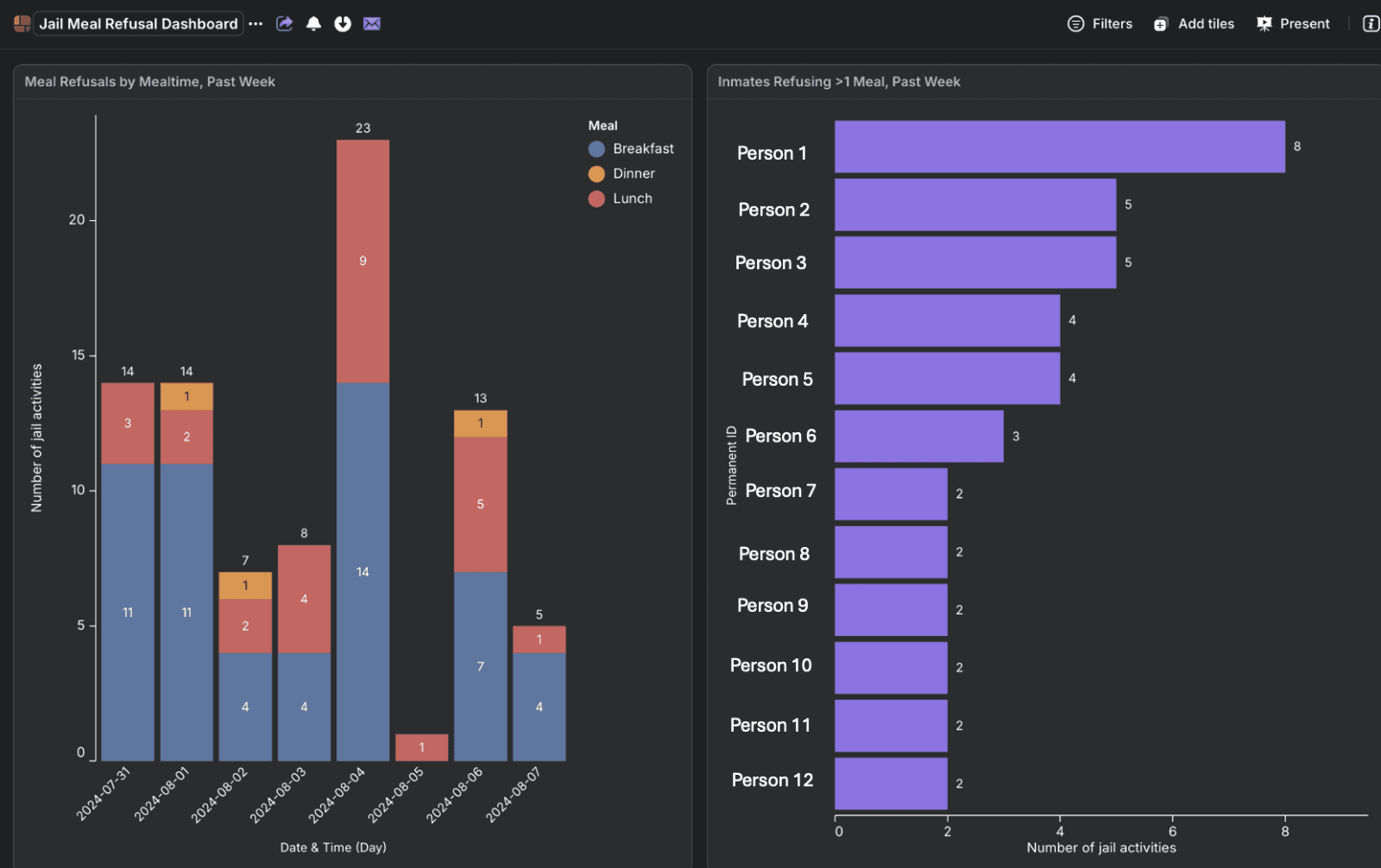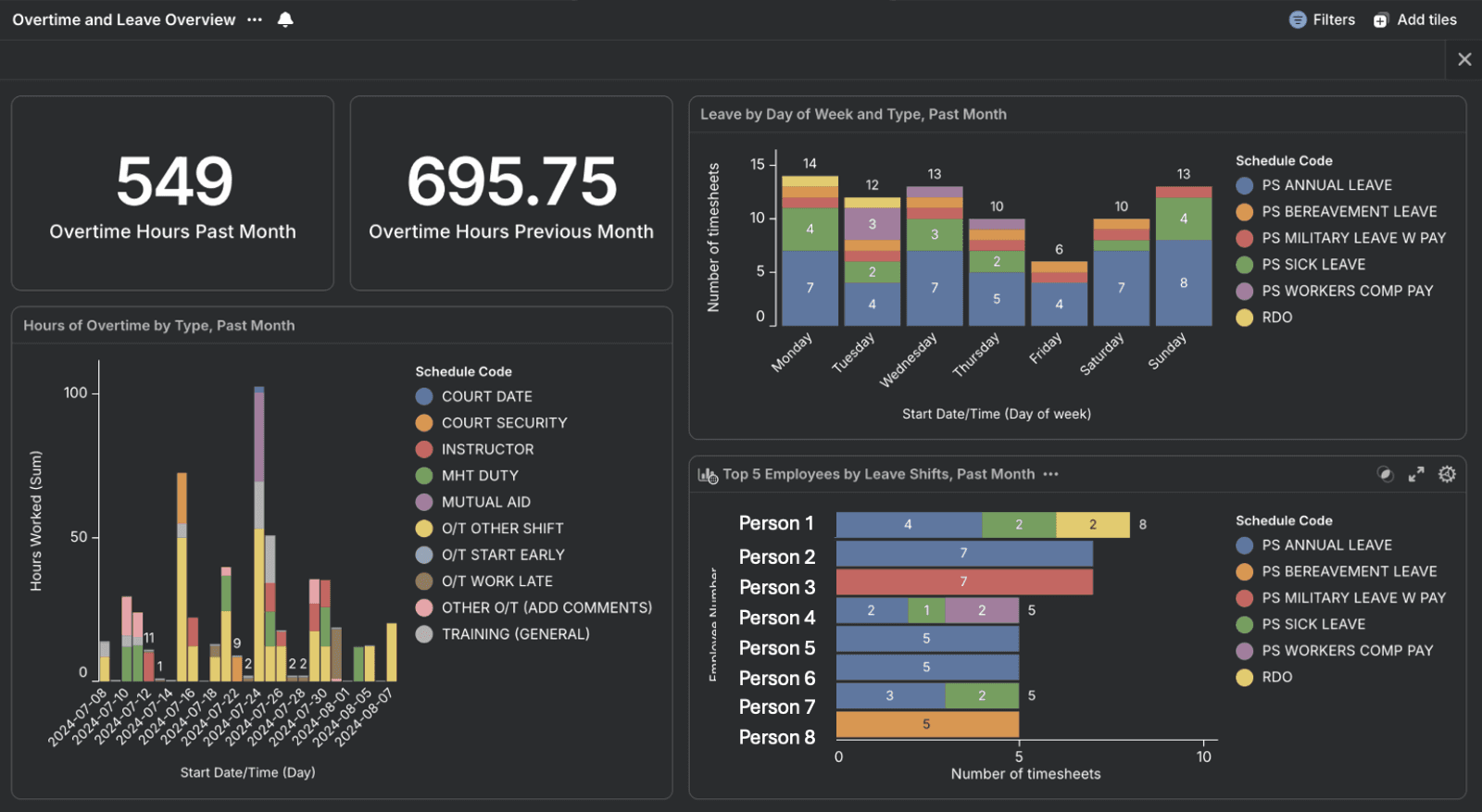3 ways custody professionals are solving critical problems with better access to data
Meredith Berger
August 19, 2024

Meredith Berger
August 19, 2024

The role of custody operations in the United States is uniquely challenging. Staff is responsible for the health and safety of inmates – from tracking nutrition to court appearances – in addition to their law enforcement duties. This already taxing job is made harder as the information needed to be effective is often trapped in disconnected systems. To eliminate this fragmentation, innovative Sheriff’s Offices are bringing their data into a single operating picture. In doing so, they gain the opportunity to harness historical and real-time information to combat key challenges. This shift doesn’t just reduce the pain of legacy systems and fragmented data; it ultimately improves the safety, health, and justice outcomes for both personnel and individuals interacting with the criminal justice system in America.
Custody personnel have long grappled with outdated systems, many of which date back to the 1980s. Many departments still rely on paper and clunky legacy tools. This results in a cumbersome process, which can look like thousands of lines of data spread across multiple static spreadsheets, making reporting inefficient and even prone to errors. It's not uncommon for Sheriff’s Offices to have decades-worth of data they can’t access or use to make decisions, which can create compliance and safety risks. In addition to legacy systems, there is often investment in newer point solutions such as jail management systems (JMS), radio frequency identification (RFID), closed-circuit television (CCTV), booking technologies, and telephone systems, to name a few. These all serve a purpose but are often siloed from one another. Between legacy systems and siloed data, it’s nearly impossible to access timely, accurate information about custody operations.
Data integration is transforming the status quo by consolidating these disparate sources into a unified view. This integration alleviates the headaches of managing multiple logins and navigating siloed information, and provides mobile and desktop-friendly access to crucial data. By streamlining information and revealing relationships between data objects, Sheriffs' Offices can now answer strategic questions more effectively and accurately, uncover valuable insights, and make better operational decisions.
Here’s how this looks in practice:
Step 1: Peregrine integrates data from your third-party or homegrown systems, all while maintaining CJIS compliance.
Step 2: Data is cleaned by deduplicating and geotagging entities, standardizing terms, and extracting information from PDFs and handwritten docs.
Step 3: Data is restructured in a way that makes sense, automatically making connections between inmates, bookings, incidents, and other data points to give your team the complete picture.
Step 4: Your department personnel can access and action real-time data through user-friendly applications including Search, Map, Dashboard, and Report.
Step 5: Using Peregrine’s powerful data infrastructure, custody data can be made available to other vendors and end-users in real-time, in tightly permissioned and highly controlled formats.
With data now accessible and actionable, departments can make informed decisions, leading to better and safer outcomes.
Seamlessly tracking data points like assaults, medical visits, and classification notes can identify who is involved in incidents and inform decisions around housing assignments, ensuring inmates with conflicting gang affiliations, for example, are not housed near one another. Similarly, an improved ability to run capacity analytics and population management can lead to safer and more sanitary conditions for inmates.
Connecting this type of information across custody operations and field operations is a game-changer for efficiency and accountability. By linking the tracking of historical incidents with real-time updates from correctional officers, facilities ensure accurate and timely information flow, which is crucial for maintaining security and reducing errors.

This dashboard uses notional data to show incidents by inmate involved and type of incident.

This dashboard uses notional data to show meal refusals by inmates, meal type, and timeframe. This type of insight can help track nutrition and health, as well as uncover insights around kitchen needs.
These insights create impact at all levels. Analyses can be securely accessed by and shared with custody leadership for a holistic view into jail operations. Beyond that, outputs can be shared with county and regional partners, to power deeper investigations and help reduce and prevent crime in contract cities and patrol areas.
“As we reimagined how we consume and manage our multiple disparate data sources, Peregrine was the logical choice. They have far exceeded our expectations and have become a key strategic partner.” - Dave Fontneau, Chief Information Officer, Orange County Sheriff’s Department
In addition to inmate insights, Sheriff’s Offices now gain a clearer view into personnel, improving decisions regarding resource allocation, employee wellness, and training. With historical and real-time data now accessible, leadership can ask questions like:
With Peregrine, it’s simple to answer these questions. Using configurable data models, departments can analyze workloads, strategically allocate resources, and set department priorities proactively with a level of depth and nuance not possible before. For example, creating dashboards around officer wellness and resilience, tracking hours worked overtime, and measuring possible exposure to traumatic incidents. Working in custody is a taxing job, and staffing shortages are at an all-time high. Making the role better and safer and modernizing the work environment can ultimately help with employee satisfaction and retention.

This dashboard uses notional data to show personnel overtime and leave.
With Peregrine, any role within the custody profession can develop workflows valuable to them. Executive leaders gain a comprehensive overview of custody operations and overall system performance. Operations leaders, on the other hand, gain insights into tactical details such as current bed availability and population trends, helping managers make informed decisions on housing assignments and resource allocation. A detective-level view analyzes patterns and anomalies in inmate behavior, aiding in the early detection of potential security threats. Peregrine’s customizable nature empowers users to find the precise information they need, when they need it. Whether it's optimizing day-to-day management or addressing high-level strategic goals.
The landscape of custody management technology is rapidly evolving, offering new possibilities for efficiency and safety. Don’t get left behind – join in the ranks of Sheriff’s Offices disrupting the status quo, harnessing the power of Peregrine to unify and maximize their data, enabling quicker, more intelligent decisions throughout their department and in their facilities.